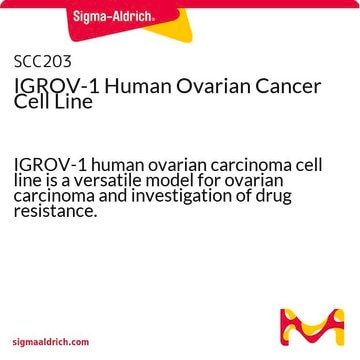SCC145
ID8 Mouse Ovarian Surface Epithelial Cell Line
Mouse
Synonym(s):
ID-8, ID8/MOSEC
About This Item
Recommended Products
product name
ID8 Mouse Ovarian Surface Epithelial Cell Line, ID8 mouse ovarian surface epithelial cell line is frequently used as a syngeneic mouse model for human ovarian cancer.
biological source
mouse
technique(s)
cell culture | mammalian: suitable
shipped in
liquid nitrogen
General description
In 2000, an immune-competent syngeneic mouse model for ovarian cancer was reported . Mouse ovarian surface epithelial cells (MOSEC) isolated from C57BL/6 mice were found to spontaneously transform into malignant tumorigenic cells following prolonged passages in vitro . Late passage MOSEC lost the classical “cobblestone” contact-inhibited in vitro properties reminiscent of normal epithelial cells and instead grew as multi-layered cell clusters indicative of transformed cells. Intraperitoneal injection of late passaged MOSEC into athymic and normal, immune-intact, syngeneic C57BL/6 mice gave rise to tumors throughout the abdominal cavity like those observed in women with Stage III and IV cancer . MOSEC are thus useful syngeneic mouse models to study the role of the immune system in the establishment and progression of ovarian cancer.
Quality
• Cells are tested negative for infectious diseases by a Mouse Essential CLEAR panel by Charles River Animal Diagnostic Services.
• Cells are verified to be of mouse origin and negative for inter-species contamination from rat, chinese hamster, Golden Syrian hamster, human and non-human primate (NHP) as assessed by a Contamination CLEAR panel by Charles River Animal Diagnostic Services.
• Cells are negative for mycoplasma contamination
Other Notes
Storage Class Code
12 - Non Combustible Liquids
WGK
WGK 1
Flash Point(F)
Not applicable
Flash Point(C)
Not applicable
Certificates of Analysis (COA)
Search for Certificates of Analysis (COA) by entering the products Lot/Batch Number. Lot and Batch Numbers can be found on a product’s label following the words ‘Lot’ or ‘Batch’.
Already Own This Product?
Find documentation for the products that you have recently purchased in the Document Library.
Our team of scientists has experience in all areas of research including Life Science, Material Science, Chemical Synthesis, Chromatography, Analytical and many others.
Contact Technical Service








